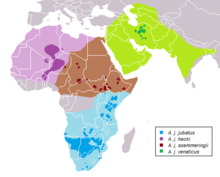Asiatic cheetah
| Asiatic cheetah | |
|---|---|
 |
|
| An Asiatic cheetah in Miandasht Wildlife Refuge, Iran. | |
| Scientific classification | |
| Kingdom: | Animalia |
| Phylum: | Chordata |
| Class: | Mammalia |
| Order: | Carnivora |
| Family: | Felidae |
| Genus: | Acinonyx |
| Species: | A. jubatus |
| Subspecies: | A. j. venaticus |
| Trinomial name | |
|
Acinonyx jubatus venaticus (Griffith, 1821) |
|
 |
|
| A. j. venaticus range (green) | |
| Synonyms | |
|
A. j. venator Brookes, 1828 |
|
A. j. venator Brookes, 1828
A. j. raddei (Hilzheimer, 1913)
The Asiatic cheetah (Acinonyx jubatus venaticus), also known as Iranian cheetah is a Critically Endangered cheetah subspecies surviving today only in Iran. It once occurred from the Arabian Peninsula to the Kyzylkum Desert, Caspian region, Pakistan and India, but has been extirpated there during the 20th century. The Indian cheetah was proposed as a subspecies by British zoologist Griffith in 1821 and was described by his assistant English naturalist Charles Hamilton Smith under the scientific name Felis venatica from India in 1827.
The Asiatic cheetah survives in protected areas in the eastern-central arid region of Iran, where the human population density is very low. Between December 2011 and November 2013, 84 individuals were sighted in 14 different protected areas, and 82 individuals were identified from camera-trap photographs. In order to raise international awareness for the conservation of the Asiatic cheetah, an illustration was used on the jerseys of the Iran national football team at the 2014 FIFA World Cup.
...
Wikipedia

